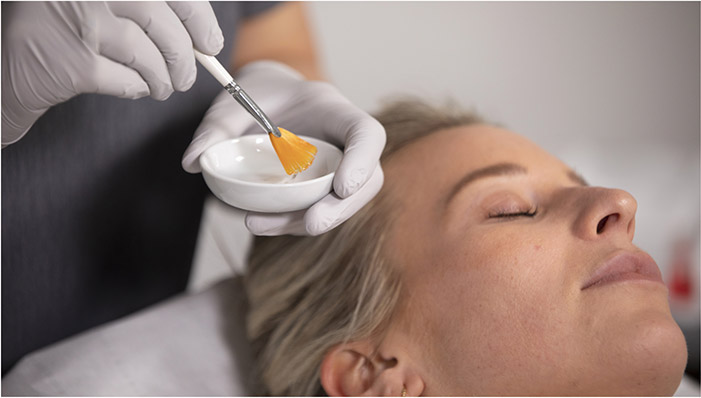Facial peels remain a common recommendation for various skin concerns, as evidenced by the fact that the majority of clinics offer them. So why are peels so popular?
If your own concerns include fine lines, dullness, pigmentation, scarring or an uneven complexion, a skin peel may still be the appropriate choice, even among all the newer treatment options available.
Despite the impression images of skin peeling may give, peels actually tackle issues at the cellular level rather than just exfoliating the skin’s top layer away. As a result, they can stimulate the production of collagen and deliver active ingredients and vitamins to the skin – overall, offering resurfacing, brightening and rejuvenating benefits.
What actually is a Skin Peel?
A chemical skin peel is a solution applied to the face to remove the top layers of skin cells and stimulate the growth of new cells, as well as trigger collagen and elastin production. The objective is to improve the appearance of skin – for example, by reducing pigmentation and improving skin tone and texture. There are 3 types of peels – superficial, medium and deep – and formulations and strength vary according to their ingredients, the percentage of their active ingredients and their PH level. Peels are administered in clinics or very superficial peels can be purchased for use at home. Gentler peels have no to little downtime whilst deeper peels do require a notable downtime period. Although ‘low tech’ – and often dismissed for that reason – peels can be highly effective, working away at cellular level, so clinicians are strong advocates of them.
Are Chemical Peels Good for Skin?
Skin peels are a considered a safe, time-efficient (and potentially budget-efficient) choice to renew skin, visibly improving scarring, fine lines and wrinkles, whilst boosting radiance and refreshing your complexion. A light chemical peel improves skin texture and tone, while lessening the appearance of fine wrinkles – expect subtle results but these increase with further treatments. A medium chemical peel should produce noticeably smoother skin, targeting both the epidermis and the upper dermis, and deeper peels treat down to the lower layers of the dermis .hence your practitioner may recommend them for more severe skin conditions.
Why Do I Need A Facial Skin Peel?
A facial skin peel may be suggested to you for numerous reasons but particularly around autumn when people often opt for this type of treatment due to summer sun damage, including pigmentation, melasma, freckles and sun spots. Our body produces pigment as a protective measure and the skin may begin to darken due to exposure to heat and sun, even when you have diligently applied sunscreen. If these changes are undesirable, you might opt for a skin peel, also because they are an effective go-to to improve overall skin clarity, texture and health.
Dr. Paris regularly recommends chemical peels for clients who suffer from lacklustre, dull skin:
“Chemical peels are my go to for reviving dull, lacklustre skin. They chemically exfoliate, help to remove impurities, detoxify your pores and promote new skin cell production through increased cellular turnover.”
What can a peel treat?
A skin peel treatment can address multiple issues, from helping to lighten pigmentation from the sun to improving your general skin quality.
The most common reasons a peel may be recommended are to help treat:
– Fine lines & wrinkles
– Acne & scarring
– Blackheads & whiteheads
– Enlarged pores
– Uneven tone
– Dullness
– Age / UV brown spots
– Hyperpigmentation
– Melasma
– Redness
– Rosacea
When IS Best to Have a Skin Peel?
As part of your post-treatment advice, it’s imperative that you avoid exposure to the sun. The darker winter months (with their less potent UV rays) are therefore the most popular time for this type of treatment.
How Do Skin Peels Work?
A facial skin peel removes the top layer of skin cells and encourages fresh new skin cells to renew and take its place. As a result it triggers elastin and collagen to be produced, creating stronger, more supple skin, with fewer signs of ageing and wrinkles.
The newly regrown skin is brighter, smoother, firmer and appears healthier as well as having less dryness and roughness on its texture.
Are All Chemical Peels The Same?
There are many different kinds of chemical peels, ranging from light superficial peels (which only remove the top layer of skin) to medium then deep peels (which remove the epidermis as well as the middle and upper layers of the dermis).
Deep chemical peels use strong chemicals and a local anaesthetic is usually needed for the procedure to prevent discomfort and pain. They are associated with some unpleasant side effects, including swelling, crusting, and severe redness, which can last for several weeks. It also takes several weeks for the skin to grow back, and during that time, surgical dressings must be worn, and pain medications are required to relieve the discomfort.
Clinics like ours often opt instead to only offer gentler superficial to medium depth peels which don’t require the use of a local anaesthetic and cause only minimal discomfort. This isn’t to negate the benefits a deep peel can offer – your practitioner will advise what, if any, is most suitable for you and how best to manage any side effects, should a deep peel be likely to give you good results.
What Are the Best Skin Peels?
There are various facial skin peel treatments to choose from. We’ll take you through three which are both innovative and effective in addressing common skin concerns and leave the skin looking healthier, clearer and more rejuvenated in a few days.
Perfect Peel
The revolutionary Perfect Peel treatment uses an innovative blend of high-quality, highly-effective anti-ageing ingredients that work together in tandem to leave the skin feeling and looking in optimum condition in a week, with further improvements over the next 4 – 6 weeks.
As this is a gentle skin peel, no anaesthetic is required for the 30 minute appointment, and with only 10 to 15 minutes of downtime, it’s a suitable lunch break treatment.
The Perfect Peel treats menopausal and sun damaged skin by restoring elasticity, reducing the appearance of wrinkles and fine lines, and generally improving the skin’s overall health for just £500 per treatment.
PCA Peel
If you’re suffering from skin hyperpigmentation or have acne or rosacea, the PCA Peel is an ideal treatment. It combines vitamins and acids in an effective treatment that improves the clarity, texture, and tone of your skin.
By effectively stimulating collagen production, this peel gives you firmer, more youthful-looking skin from a single treatment. Taking just 30 minutes, this £500 treatment requires no anaesthetic and causes minimal discomfort.
Obagi Radiance
If you’d like to achieve a visible, instant glow for your tired, dull skin, the Obagi Radiance skin peel is a good choice.
By combining lactic, glycolic, and salicylic acids, this treatment refines the pores, reduces acne and pigmentation, and improves the appearance of wrinkles and fine lines, exfoliating the damaged uppermost skin layers to leave your skin feeling and looking renewed, radiant, and fresh.
Although this is a highly effective treatment, it takes just 30 minutes and requires no anaesthetic since it causes minimal discomfort.
Is There a Skincare Alternative to a Skin Peel?
If you don’t have time for a clinic visit currently, you might like to try skincare with peel-type benefits. If you’d like to boost your skin clarity while also fading the appearance of dark spots to achieve a more even, brighter complexion, consider ZO Skin Health’s Brightalive skincare product. It’s a technologically advanced skin brightener treatment which is clinically proven to boost skin’s luminosity yet doesn’t contain retinol or hydroquinone.
Is A Skin Peel Right For Me?
If you feel your skin may benefit from a facial skin peel or you have issues with your skin you’d like to discuss, book a consultation with your practitioner or a team like ours. A skin professional will advise you about the best treatment to suit your skin needs and how to achieve your desired results. Your practitioner should also give you helpful advice about how to prolong your results so you maximise the benefits from treatment.
How Much Is A Skin Peel?
Prices will vary depending on which peel you have and where you have treatment. Expect to pay in the region of £100 to £500. A skilled practitioner will make sure you have all the information you need so you make a well-informed decision about treatment.
Any Questions?
Don’t hesitate to contact us if you have any questions – we’ll be happy to help.






